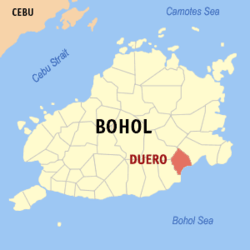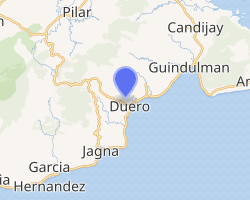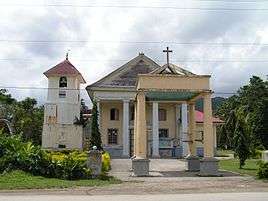Duero, Bohol
Duero, officially the Municipality of Duero (Cebuano: Lungsod sa Duero; Tagalog: Bayan ng Duero), is a 4th class municipality in the province of Bohol, Philippines. According to the 2015 census, it has a population of 17,876 people.[4]
Duero | |
|---|---|
| Municipality of Duero | |
Duero | |
 Map of Bohol with Duero highlighted | |
OpenStreetMap 
| |
.svg.png) Duero Location within the Philippines | |
| Coordinates: 9°43′N 124°24′E | |
| Country | |
| Region | Central Visayas (Region VII) |
| Province | Bohol |
| District | 3rd District |
| Founded | 1862 |
| Barangays | 21 (see Barangays) |
| Government | |
| • Type | Sangguniang Bayan |
| • Mayor | Conrada C. Amparo |
| • Vice Mayor | Gillian R. Achacoso |
| • Congressman | Kristine Alexie B. Tutor |
| • Electorate | 13,695 voters (2019) |
| Area | |
| • Total | 97.30 km2 (37.57 sq mi) |
| Elevation | 5.3 m (17.4 ft) |
| Population (2015 census)[4] | |
| • Total | 17,876 |
| • Density | 180/km2 (480/sq mi) |
| • Households | 4,000 |
| Economy | |
| • Income class | 4th municipal income class |
| • Poverty incidence | 29.6% (2015)[5] |
| • Revenue (₱) | 65,793,545.56 (2016) |
| Time zone | UTC+8 (PST) |
| ZIP code | 6309 |
| PSGC | |
| IDD : area code | +63 (0)38 |
| Climate type | tropical monsoon climate |
| Native languages | Boholano dialect Cebuano Eskayan Tagalog |
It may have been named after the Douro (Duero) in the Iberian peninsula. Roman Catholicism was introduced to the town in 1860 by a Spanish priest. Duero was established as a municipality two years later, and a convent was constructed in 1868.[6]
The town of Duero, Bohol celebrates its fiesta on December 8, to honor the town patron Immaculate Conception.[7]
Barangays
Duero comprises 21 barangays:
| PSGC | Barangay | Population | ±% p.a. | |||
|---|---|---|---|---|---|---|
| 2015[4] | 2010[8] | |||||
| 071221001 | Alejawan | 4.3% | 773 | 801 | −0.68% | |
| 071221002 | Angilan | 2.9% | 514 | 540 | −0.94% | |
| 071221003 | Anibongan | 2.7% | 479 | 540 | −2.26% | |
| 071221004 | Bangwalog | 7.6% | 1,358 | 1,340 | 0.25% | |
| 071221005 | Cansuhay | 4.4% | 789 | 735 | 1.36% | |
| 071221006 | Danao | 3.6% | 646 | 688 | −1.19% | |
| 071221007 | Duay | 2.7% | 482 | 390 | 4.12% | |
| 071221008 | Guinsularan | 9.4% | 1,689 | 1,736 | −0.52% | |
| 071221020 | Imelda | 3.4% | 603 | 615 | −0.37% | |
| 071221009 | Itum | 6.3% | 1,135 | 1,139 | −0.07% | |
| 071221010 | Langkis | 7.5% | 1,338 | 1,002 | 5.66% | |
| 071221011 | Lobogon | 6.2% | 1,103 | 1,329 | −3.49% | |
| 071221012 | Madua Norte | 2.9% | 515 | 475 | 1.55% | |
| 071221013 | Madua Sur | 4.1% | 731 | 699 | 0.86% | |
| 071221014 | Mambool | 3.4% | 607 | 556 | 1.69% | |
| 071221015 | Mawi | 2.9% | 523 | 518 | 0.18% | |
| 071221016 | Payao | 3.6% | 639 | 598 | 1.27% | |
| 071221017 | San Antonio (Poblacion) | 6.6% | 1,181 | 1,211 | −0.48% | |
| 071221018 | San Isidro | 4.6% | 816 | 809 | 0.16% | |
| 071221019 | San Pedro | 8.2% | 1,467 | 1,334 | 1.83% | |
| 071221021 | Taytay | 3.4% | 611 | 525 | 2.93% | |
| Total | 17,876 | 17,580 | 0.32% | |||
Climate
| Climate data for Duero, Bohol | |||||||||||||
|---|---|---|---|---|---|---|---|---|---|---|---|---|---|
| Month | Jan | Feb | Mar | Apr | May | Jun | Jul | Aug | Sep | Oct | Nov | Dec | Year |
| Average high °C (°F) | 28 (82) |
29 (84) |
30 (86) |
31 (88) |
31 (88) |
30 (86) |
30 (86) |
30 (86) |
30 (86) |
29 (84) |
29 (84) |
29 (84) |
30 (85) |
| Average low °C (°F) | 23 (73) |
22 (72) |
23 (73) |
23 (73) |
24 (75) |
25 (77) |
24 (75) |
24 (75) |
24 (75) |
24 (75) |
23 (73) |
23 (73) |
24 (74) |
| Average precipitation mm (inches) | 102 (4.0) |
85 (3.3) |
91 (3.6) |
75 (3.0) |
110 (4.3) |
141 (5.6) |
121 (4.8) |
107 (4.2) |
111 (4.4) |
144 (5.7) |
169 (6.7) |
139 (5.5) |
1,395 (55.1) |
| Average rainy days | 18.6 | 14.8 | 16.5 | 16.7 | 23.9 | 26.4 | 25.6 | 24.1 | 24.4 | 26.3 | 23.7 | 20.5 | 261.5 |
| Source: Meteoblue [9] | |||||||||||||
Demographics
| Population census of Duero | ||
|---|---|---|
| Year | Pop. | ±% p.a. |
| 1903 | 6,853 | — |
| 1918 | 8,314 | +1.30% |
| 1939 | 9,272 | +0.52% |
| 1948 | 8,939 | −0.41% |
| 1960 | 8,929 | −0.01% |
| 1970 | 9,965 | +1.10% |
| 1975 | 11,522 | +2.95% |
| 1980 | 11,619 | +0.17% |
| 1990 | 14,242 | +2.06% |
| 1995 | 14,299 | +0.07% |
| 2000 | 16,485 | +3.10% |
| 2007 | 17,254 | +0.63% |
| 2010 | 17,580 | +0.68% |
| 2015 | 17,876 | +0.32% |
| Source: Philippine Statistics Authority[4][8][10][11] | ||
Gallery
- Duero town hall
- Public market
 Church
Church
References
- "Municipality". Quezon City, Philippines: Department of the Interior and Local Government. Retrieved 31 May 2013.
- "Province: Bohol". PSGC Interactive. Quezon City, Philippines: Philippine Statistics Authority. Retrieved 12 November 2016.
- "Duero, Bohol Profile". PhilAtlas.com. Retrieved 15 June 2020.
- Census of Population (2015). "Region VII (Central Visayas)". Total Population by Province, City, Municipality and Barangay. PSA. Retrieved 20 June 2016.
- "PSA releases the 2015 Municipal and City Level Poverty Estimates". Quezon City, Philippines. Retrieved 12 October 2019.
- "Municipality of Duero". Retrieved 30 January 2015.
- "Bohol Festivals Timetable". "www.bohol-philippines.com". Retrieved 2019-03-07.
- Census of Population and Housing (2010). "Region VII (Central Visayas)". Total Population by Province, City, Municipality and Barangay. NSO. Retrieved 29 June 2016.
- "Duero: Average Temperatures and Rainfall". Meteoblue. Retrieved 9 May 2020.
- Censuses of Population (1903–2007). "Region VII (Central Visayas)". Table 1. Population Enumerated in Various Censuses by Province/Highly Urbanized City: 1903 to 2007. NSO.
- "Province of Bohol". Municipality Population Data. Local Water Utilities Administration Research Division. Retrieved 17 December 2016.
| Wikimedia Commons has media related to Duero. |
External links
This article is issued from Wikipedia. The text is licensed under Creative Commons - Attribution - Sharealike. Additional terms may apply for the media files.